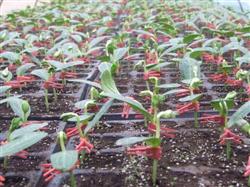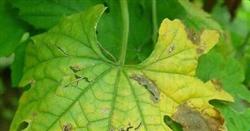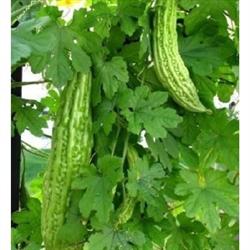Pollution-free and efficient cultivation techniques of balsam pear in greenhouse

Balsam pear, also known as mangy melon, is not only rich in protein and a variety of vitamins necessary for the human body, but also has medicinal effects such as helping digestion, clearing poison and dispelling fire, and is deeply welcomed by consumers. In recent years, with the continuous improvement of people's living standards, the output is far from meeting the market demand. The implementation of greenhouse pollution-free cultivation technology can not only increase the yield, but also supply the city during the Spring Festival, and obtain high economic benefits. The main cultivation techniques are as follows: the selected excellent varieties of balsam pear like temperature, heat resistance, humidity, fear of waterlogging and wide adaptability. In greenhouse cultivation, medium and early maturing varieties with moderate branching ability, strong growth potential, good stress resistance, high quality and high yield, such as long body balsam pear, Xiafeng balsam pear and Penang balsam pear should be selected. The suitable time for sowing balsam pear is about 100 days from sowing to harvest. According to the production conditions of the shed, and try to ensure the picking and listing before and after the Spring Festival, the sowing date is usually determined to be the most suitable from late September to early October. Before sowing, the strong seedlings were prepared to be sown 15-20 days before sowing, 667 square meters were applied with rotten barnyard manure 4000~5000Kg, after spreading evenly, deep ploughing and drying for 7 days, and then sealed in the shed for 5 days. Fully sterilize and disinfect the soil through sunlight exposure and high temperature greenhouse. Then, on one side of the shed, along the north-south direction, the nursery bed was set up according to the specification of 6 ~ 7m in length and 1.1 ~ 1.3m in width. The seed shell of Momordica charantia seeds is thick and hard, and the seeds must be soaked and germinated before sowing. After the seeds are soaked in hot water of 60 ℃, scald the 20~30min, scrub the mucus on the surface of the seed shell, soak it in warm water of 30 ℃ for 6 hours, remove it and put it into 10% trisodium phosphate solution, soak and disinfect 15~20min, which can be placed at a temperature of 30 ℃ and 35 ℃ to moisturize and accelerate germination. Generally, 667 square meters are used for planting 750g to 1000g. When more than 50% of the seeds are exposed to white, the seedlings can be sown. Pour the bottom water thoroughly before sowing, and after the water is completely infiltrated, according to the density of 10cm × 10cm, the germinated seeds are sown on the seedbed and covered with fine soil 1.5~2cm. Then set up a small arch shed to keep the temperature in the arch shed about 25 ℃. When the seedlings grow to two leaves in one heart, gradually lift the film on the arch shed to release the wind to refine the seedlings. Try not to water or less water at the seedling stage to prevent the seedlings from overgrowing. When aphids or whitefly are found, 2500 times of imidacloprid wettable powder can be sprayed to kill insects and cultivate non-toxic strong seedlings. Transplanting in time when the seedlings grow 4-5 leaves, they can be fixed and transplanted. Before transplanting, the plastic film was covered along the ridge, and the film was drilled and planted according to the distance between the rows of 70~80cm plants and 30~35cm. When taking seedlings, try to keep the soil intact to avoid root damage as far as possible. The planting depth should be on the surface of cotyledons. After planting, the smoke is irrigated along the film, and the opening of the film is pressed tightly with wet soil, and then the shed is sealed to raise the temperature and slow the seedling. After pruning and planting slow seedlings, the greenhouse temperature was kept at 20: 25 ℃ during the day and 15: 18 ℃ at night. After the plant extends the vine, use the crossbeam at the north and south end of the shed to fix the waste telephone line or iron wire along the top of the seedling ridge, hang the nylon rope according to the plant spacing on the cable, and lead the vine to the shelf in time. Momordica charantia has strong branching power and luxuriant growth of lateral vines. If allowed to grow, it will not only waste nutrients, hinder the normal growth, flowering and fruiting of the main vines, but also cause canopy closure and affect the ventilation and light transmission of the greenhouse. Therefore, in the process of introducing vines, the lateral vines of the plants should be removed in time, and the over-dense old leaves and yellow leaves should be removed in order to enhance light cooperation. With centralized nutrition supply, it is beneficial to the growth of main vine and fruit coloring. The suitable temperature for flowering and fruiting of balsam pear regulated by temperature and light is about 25 ℃. When the greenhouse temperature exceeds 25 ℃ during the day, the film can be released, the greenhouse temperature at night should be kept at about 15 ℃, and the minimum temperature in the early morning should not be lower than 12 ℃. Fine weather, open the grass at 9: 00 am and put it down after 4: 00 pm. When the outside temperature drops, you can cover the grass grass with a layer of paper quilt or old film to keep warm from the cold, and appropriately shorten the release time. In case of overcast, cold, rainy and snowy weather, in addition to prolonging the covering time, it is necessary to remove the residual snow and dirt on the greenhouse film as soon as possible, hang a reflective screen and supplementary lights, increase the illumination of the shed, and increase the greenhouse temperature to meet the growth needs of balsam pear. Fertilizer and water management from transplanting to flowering, balsam pear plants are smaller, water and fertilizer requirements are less. When entering the flowering and fruiting stage, the amount of fertilizer required increases rapidly, and fertilizer can be topdressing by stages at the time of budding, fruit setting and picking. When topdressing, can be combined with watering, appropriate amount of rotten chicken manure or humic acid compound fertilizer. When watering, small water should be watered frequently, do not flood irrigation, generally choose before noon in sunny days, cold weather can not be watered. Artificial pollination of balsam pear is a kind of cross-pollination crop. There are few pollinator insects in greenhouse cultivation environment. Artificial pollination can effectively improve fruit setting rate and fruit quality. The pollination time was generally from 6 to 10 o'clock last year. At the same time, smearing the female flower with 2mai 4murD could effectively reduce the lotus flower and significantly increase the fruit setting rate. Balsam pear has strong resistance to disease and pest control, and it is rarely attacked by diseases and insect pests when cultivated in greenhouse. If aphids, whitefly and melon fruit fly are found to harm or infect anthracnose and spot disease, and reach the control target, the closed environment naturally formed in the greenhouse can be used to select pollution-free pesticides with high efficiency, low toxicity and low residue. such as imidacloprid, avermectin, aphid smoke agent, chlorothalonil smoke remover and so on. When picking balsam pear, tender gourd is the main food, and the picking period is more strict. Generally, 10-12 days after anthesis, the apical Corolla dries up and falls off, the fruit grows fully, and the strips and verrucous grains on the pericarp expand rapidly, protruding obviously, full and full, bright color, and the variety characteristics can be picked. When picking, the fruit stalk should be cut with fruit shears to prevent ripping and pulling the fruit, affecting the storage and commodity value of balsam pear.
- Prev

Seize the time to control eggplant, melon and balsam pear diseases
The new leaves become narrow, shriveled, hardened and twisted, the diseased plants are obviously dwarfed, it is difficult to sit, even if they sit, they are deformed, hardened and mottled on the surface. % 26rdquo; Recently, a farmer took a sick balsam pear vine, anxious to find the city plant protection station consultation and reflect to the author, asked what disease, and seek solutions...
- Next

Scientific fertilization method of bitter gourd
High yield and high benefit cultivation technique of balsam pear in winter warm plastic greenhouse. Compared with cucumber, loofah and summer squash, balsam pear requires higher light intensity, higher temperature, lower temperature tolerance and poor light resistance. Balsam pear...
Related
- Where is it suitable to grow horseradish in China? it is expected to see the middle altitude horseradish in Alishan.
- How to prevent tomato virus disease reasonably? (Control methods included)
- Many people like to plant towel gourd on the balcony. What are the main points of this method and management?
- What crops can chili peppers be mixed with?
- Fertilization techniques and matters needing attention in Tomato
- What are the grafting techniques for peach seedlings in spring?
- Harm and control methods of root swelling disease of Chinese cabbage
- What are the pests of sweet potatoes? How to prevent and cure it?
- Symptoms, causes and Control methods of navel Rot in Tomato
- The cause of "Cucumber rotten bibcock" in Farmers' planting Cucumber and its Control Plan

